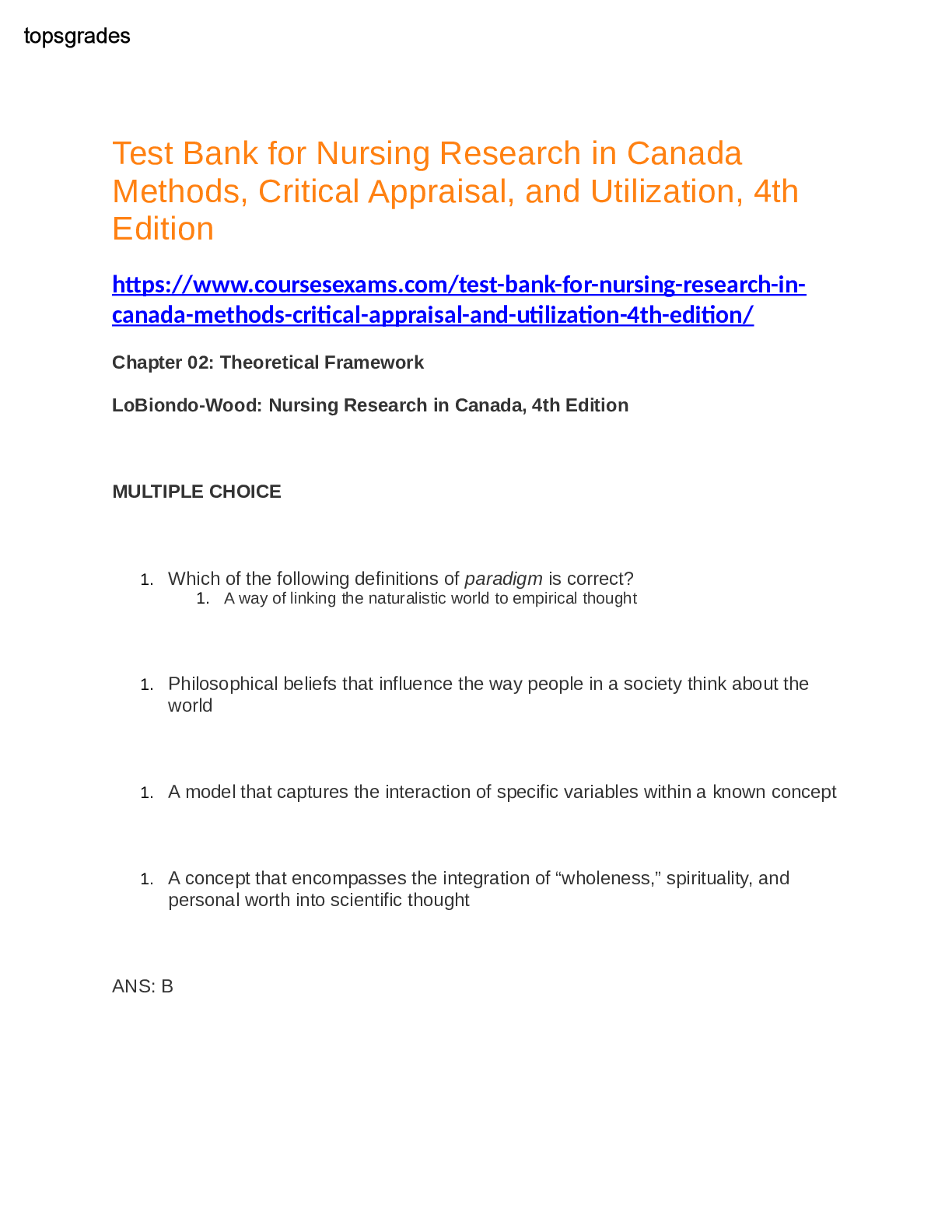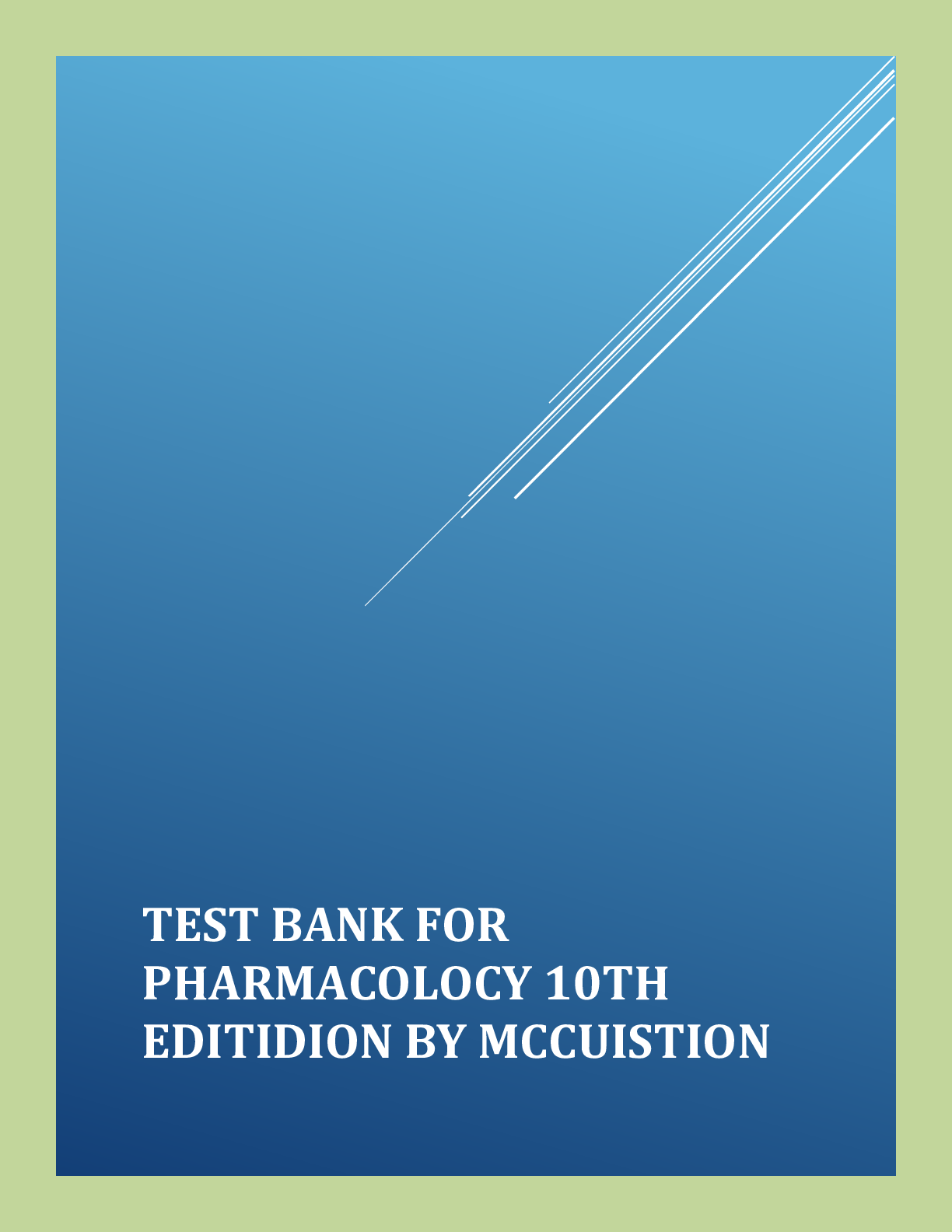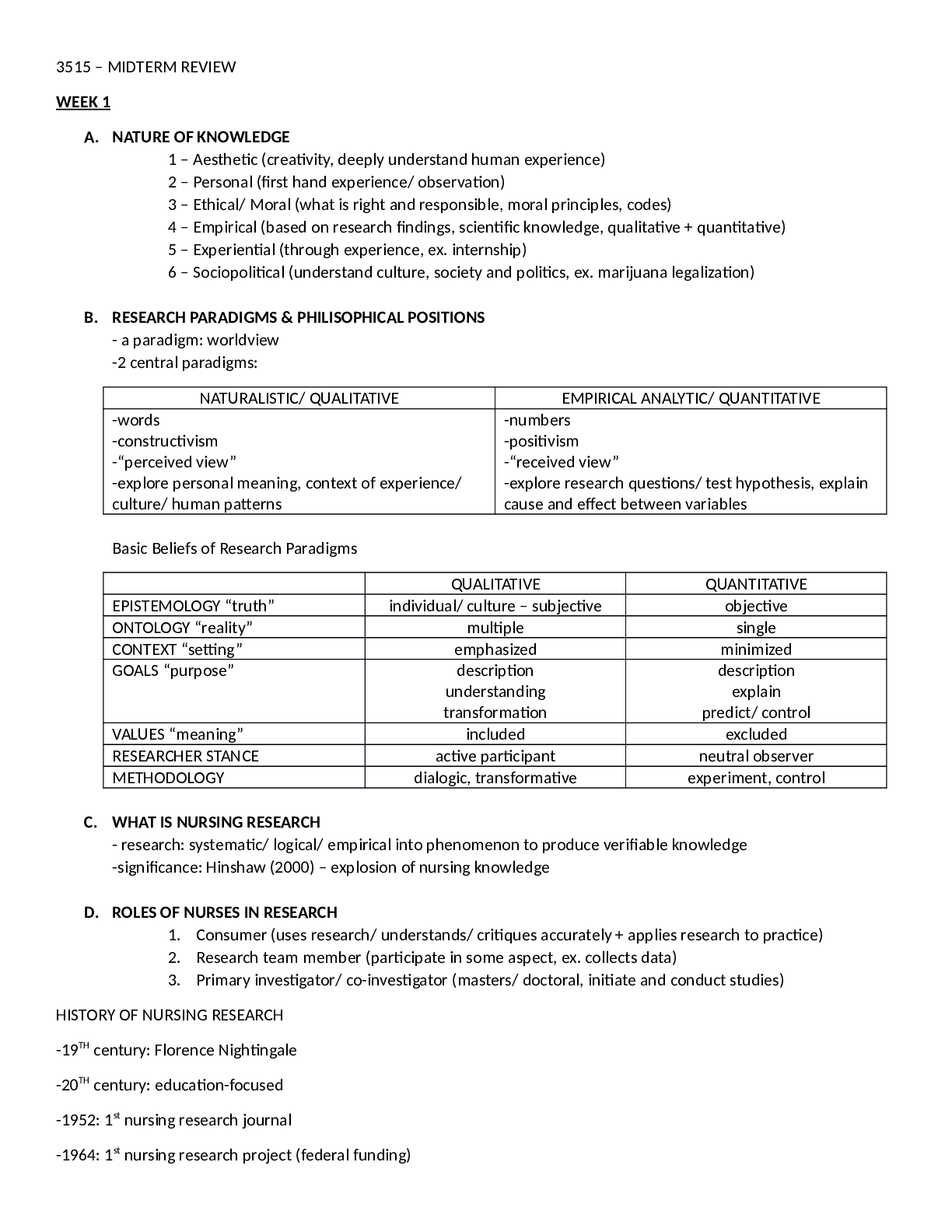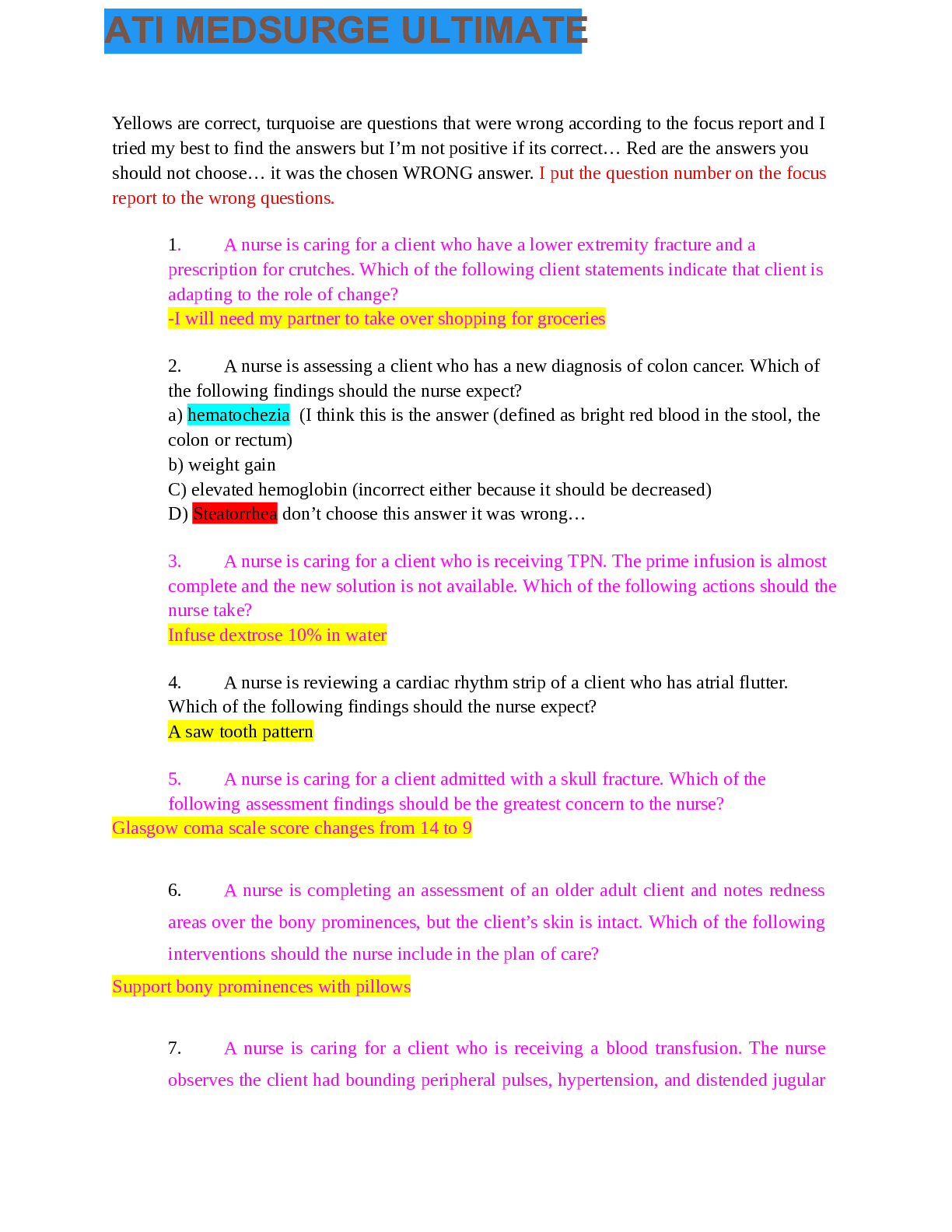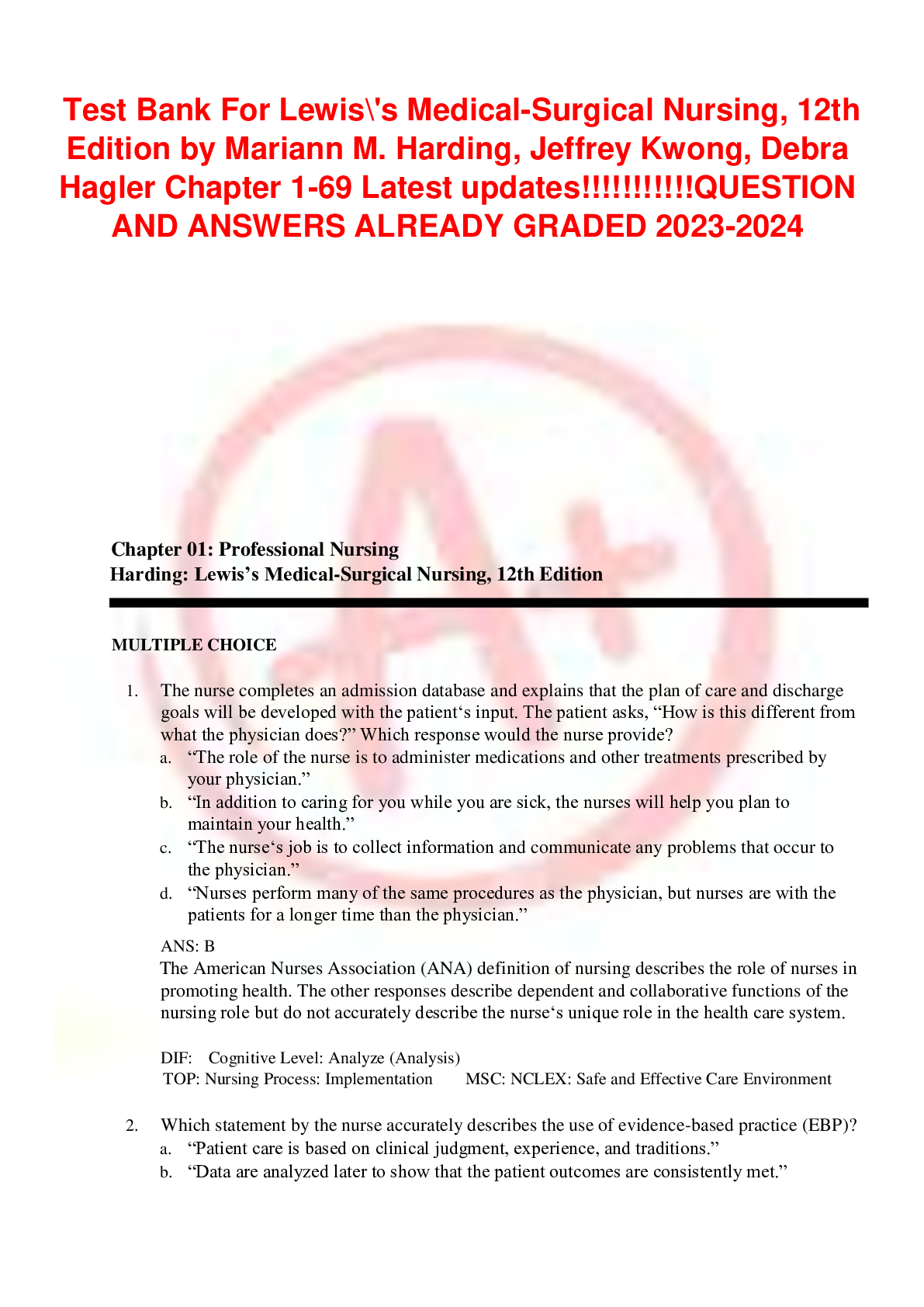*NURSING > AQA Questions and Marking Scheme > Test Bank for Lewis\'s Medical-Surgical Nursing, 12th Edition by Mariann M. Harding, Jeffrey Kwong, (All)
Test Bank for Lewis\'s Medical-Surgical Nursing, 12th Edition by Mariann M. Harding, Jeffrey Kwong, Debra Hagler Chapter 1-69
Document Content and Description Below
Chapter 01: Professional Nursing Harding: Lewis’s Medical-Surgical Nursing, 12th Edition MULTIPLE CHOICE 1. The nurse completes an admission database and explains that the plan of care and discha... rge goals will be developed with the patient‘s input. The patient asks, “How is this different from what the physician does?” Which response would the nurse provide? a. “The role of the nurse is to administer medications and other treatments prescribed by your physician.” b. “In addition to caring for you while you are sick, the nurses will help you plan to maintain your health.” c. “The nurse‘s job is to collect information and communicate any problems that occur to the physician.” d. “Nurses perform many of the same procedures as the physician, but nurses are with the patients for a longer time than the physician.” ANS: B The American Nurses Association (ANA) definition of nursing describes the role of nurses in promoting health. The other responses describe dependent and collaborative functions of the nursing role but do not accurately describe the nurse‘s unique role in the health care system. DIF: Cognitive Level: Analyze (Analysis) TOP: Nursing Process: Implementation MSC: NCLEX: Safe and Effective Care Environment 2. Which statement by the nurse accurately describes the use of evidence-based practice (EBP)? a. “Patient care is based on clinical judgment, experience, and traditions.” b. “Data are analyzed later to show that the patient outcomes are consistently met.” c. “Research from all published articles are used as a guide for planning patient care.” d. “Recommendations are based on research, clinical expertise, and patient preferences.” ANS: D Evidence-based practice (EBP) is the use of the best research-based evidence combined with clinician expertise and consideration of patient preferences. Clinical judgment based on the nurse‘s clinical experience is part of EBP, but clinical decision making should also incorporate current research and research-based guidelines. Evaluation of patient outcomes is important, but data analysis is not required to use EBP. All published articles do not provide research evidence; interventions should be based on credible research, preferably randomized controlled studies with a large number of subjects. DIF: Cognitive Level: Understand (Comprehension) TOP: Nursing Process: Planning MSC: NCLEX: Safe and Effective Care Environment 3. Which statement by the nurse provides a clear explanation of the nursing process? a. “The nursing process is a research method of diagnosing the patient‘s health care problems.” b. “The nursing process is used primarily to explain nursing interventions to other health care professionals.” c. “The nursing process is a problem-solving tool used to identify and manage the A+ patients‘ health care needs.” d. “The nursing process is based on nursing theory that incorporates the biopsychosocial nature of humans.” ANS: C The nursing process is a problem-solving approach to the identification and treatment of patients‘ problems. Nursing process does not require research methods for diagnosis. The primary use of the nursing process is in patient care, not to establish nursing theory or explain nursing interventions to other health care professionals. DIF: Cognitive Level: Understand (Comprehension) TOP: Nursing Process: Evaluation MSC: NCLEX: Safe and Effective Care Environment 4. A patient admitted to the hospital for surgery tells the nurse, “I do not feel comfortable leaving my children with my parents.” Which action would the nurse take next? a. Reassure the patient that these feelings are common for parents. b. Have the patient call the children to ensure that they are doing well. c. Gather information on the patient‘s concerns about the child care arrangements. d. Call the patient‘s parents to determine whether adequate child care is being provided. ANS: C Because a complete assessment is necessary in order to identify a problem and choose an appropriate intervention, the nurse‘s first action should be to obtain more information. The other actions may be appropriate, but more assessment is needed before the best intervention can be chosen. DIF: Cognitive Level: Analyze (Analysis) TOP: Nursing Process: Assessment MSC: NCLEX: Psychosocial Integrity 5. A patient with a bacterial infection is hypovolemic due to a fever and excessive diaphoresis. Which expected outcome would the nurse select for this patient? a. Patient has a balanced intake and output. b. Patient‘s bedding is kept clean and free of moisture. c. Patient understands the need for increased fluid intake. d. Patient‘s skin remains cool and dry throughout hospitalization. ANS: A Balanced intake and output gives measurable data showing resolution of the problem of deficient fluid volume. The other statements would not indicate that the problem of hypovolemia was resolved. DIF: Cognitive Level: Apply (Application) TOP: Nursing Process: Planning MSC: NCLEX: Physiological Integrity 6. Which statement describes the purpose of the evaluation phase of the nursing process? a. To document the nursing care plan in the progress notes of the health record b. To determine if interventions have been effective in meeting patient outcomes c. To decide whether the patient‘s health problems have been completely resolved d. To establish if the patient agrees that the nursing care provided was satisfactory ANS: B A+ Evaluation consists of determining whether the desired patient outcomes have been met and whether the nursing interventions were appropriate. The other responses do not describe the evaluation phase. DIF: Cognitive Level: Understand (Comprehension) TOP: Nursing Process: Evaluation MSC: NCLEX: Safe and Effective Care Environment 7. Which statement describes the purpose of the assessment phase of the nursing process? a. To teach interventions that relieve health problems b. To use patient data to evaluate patient care outcomes c. To obtain data to diagnose patient strengths and problems d. To help the patient identify realistic outcomes for health problems ANS: C During the assessment phase, the nurse gathers information about the patient to diagnose patient strengths and problems. The other responses are examples of the planning, intervention, and evaluation phases of the nursing process. DIF: Cognitive Level: Understand (Comprehension) TOP: Nursing Process: Assessment MSC: NCLEX: Safe and Effective Care Environment 8. When developing the plan of care, which components would the nurse include in the clinical problem statement? a. The problem and the suggested patient goals or outcomes b. The problem, its causes, and the signs and symptoms of the problem c. The problem with the possible etiology and the planned interventions d. The problem, its pathophysiology, and the expected outcome ANS: B When writing clinical problems or nursing diagnoses, the subjective as well as objective data to support the problem‘s existence should be included. Goals, outcomes, and interventions are not included in the problem statement. DIF: Cognitive Level: Understand (Comprehension) TOP: Nursing Process: Diagnosis MSC: NCLEX: Safe and Effective Care Environment 9. Which patient care task would the nurse delegate to experienced assistive personnel (AP)? a. Instruct the patient about the need to alternate activity and rest. b. Monitor level of shortness of breath or fatigue after ambulation. c. Obtain the patient‘s blood pressure and pulse rate after ambulation. d. Determine whether the patient is ready to increase the activity level. ANS: C AP education includes accurate vital sign measurement. Assessment and patient teaching require registered nurse education and scope of practice and cannot be delegated. DIF: Cognitive Level: Apply (Application) TOP: Nursing Process: Planning MSC: NCLEX: Safe and Effective Care Environment A+ 10. A nurse is caring for a group of patients on the medical-surgical unit with the help of one float registered nurse (RN), one assistive personnel (AP), and one licensed practical/vocational nurse (LPN/VN). Which assignment, if delegated by the nurse, would be outside that individual‘s scope of practice? a. Check for the presence of bowel sounds by AP b. Administration of oral medications by LPN/VN c. Insulin administration by float RN from the pediatric unit d. Measurement of a patient‘s urinary catheter output by AP ANS: A Assessment requires RN education and scope of practice so it cannot be delegated to an LPN/VN or AP. The other assignments made by the RN are appropriate for the role of the team member. DIF: Cognitive Level: Apply (Application) TOP: Nursing Process: Planning MSC: NCLEX: Safe and Effective Care Environment 11. Which task is appropriate for the nurse to delegate to a licensed practical/vocational nurse (LPN/VN)? a. Complete the initial admission assessment and plan of care. b. Measure bedside blood glucose before administering insulin. c. Document teaching completed before a diagnostic procedure. d. Instruct a patient about low-fat, reduced sodium dietary restrictions. ANS: B The education and scope of practice of the LPN/LVN include activities such as obtaining glucose testing using a finger stick and administering insulin. Patient teaching and the initial assessment and development of the plan of care are nursing actions that require registered nurse education and scope of practice. DIF: Cognitive Level: Apply (Application) TOP: Nursing Process: Planning MSC: NCLEX: Safe and Effective Care Environment 12. A nurse is assigned as a case manager for a hospitalized patient who has a spinal cord injury. Which activity can the patient expect the nurse in this role to perform? a. Care for the patient during hospitalization for the injuries. b. Assist the patient with home care activities during recovery. c. Coordinate the services the patient receives in the hospital and at home. d. Determine what medical care the patient needs for optimal rehabilitation. ANS: C The role of the case manager is to coordinate the patient‘s care through multiple settings and levels of care to allow the maximal patient benefit at the least cost. The case manager does not provide direct care in the acute or home setting. The case manager coordinates and advocates for care. The HCP determines what medical care is needed. DIF: Cognitive Level: Apply (Application) TOP: Nursing Process: Implementation MSC: NCLEX: Safe and Effective Care Environment 13. The nurse is caring for an older adult patient who needs continued nursing care and physical therapy to improve mobility after surgery to repair a fractured hip. The nurse would help to arrange for transfer of the patient to which type of facility? A+ a. A skilled care facility b. A transitional care facility c. A residential care facility d. An intermediate care facility ANS: B Transitional care settings are appropriate for patients who need continued rehabilitation before discharge to home or to long-term care settings. The patient is no longer in need of the more continuous assessment and care given in acute care settings. There is no indication that the patient will need the permanent and ongoing medical and nursing services available in intermediate or skilled care. The patient is not yet independent enough to transfer to a residential care facility. DIF: Cognitive Level: Apply (Application) TOP: Nursing Process: Planning MSC: NCLEX: Safe and Effective Care Environment 14. A home care nurse is planning care for a patient who has just been diagnosed with type 2 diabetes. Which task is appropriate for the nurse to delegate to the home health aide? a. Assist the patient to choose appropriate foods. b. Help the patient with a daily bath and oral care. c. Check the patient‘s feet for signs of breakdown. d. Teach the patient how to monitor blood glucose. ANS: B Assisting with patient hygiene is included in home health-aide education and scope of practice. Assessment o [Show More]
Last updated: 1 year ago
Preview 1 out of 642 pages
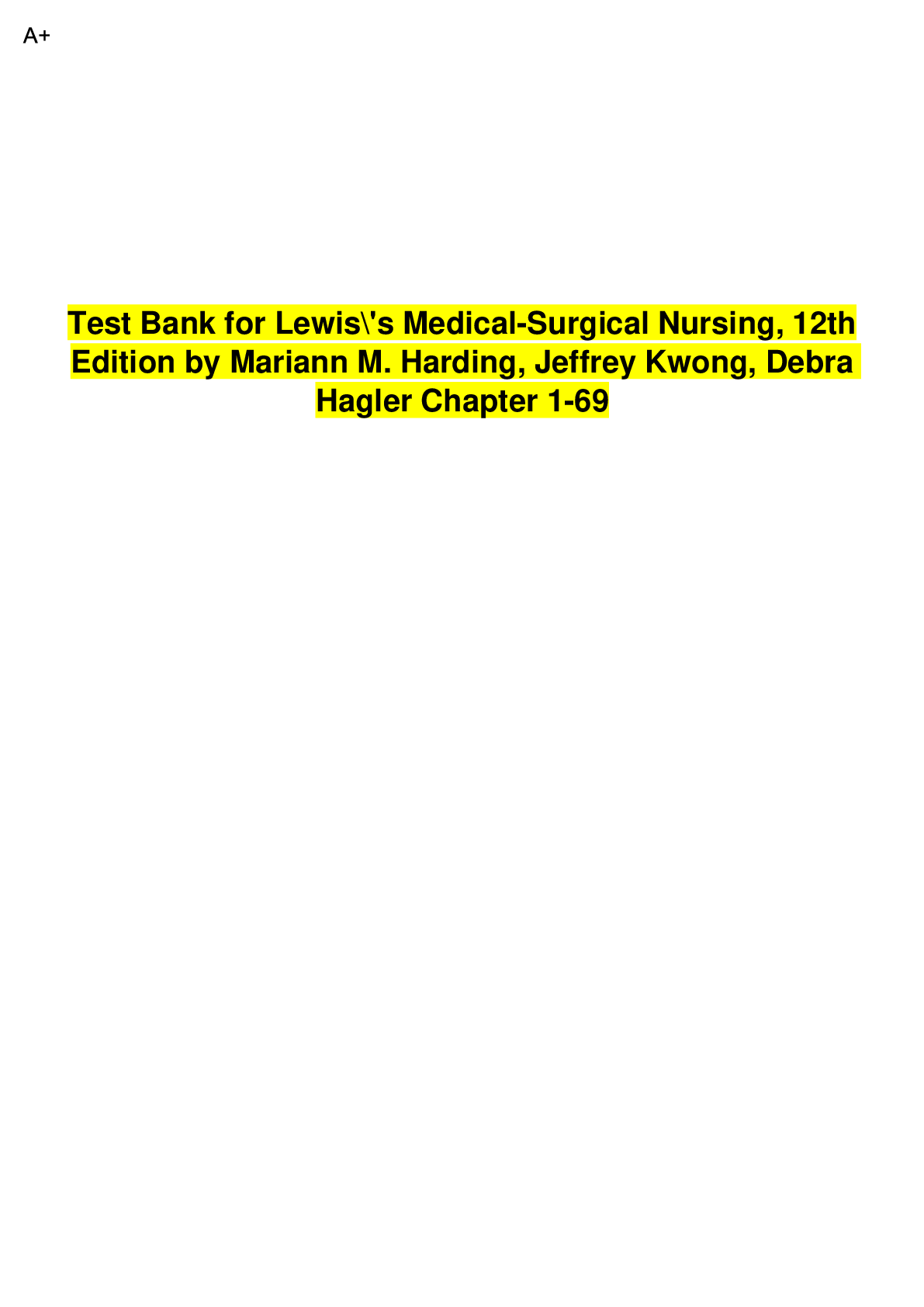
Buy this document to get the full access instantly
Instant Download Access after purchase
Add to cartInstant download
We Accept:

Reviews( 0 )
$14.00
Document information
Connected school, study & course
About the document
Uploaded On
Apr 03, 2023
Number of pages
642
Written in
Additional information
This document has been written for:
Uploaded
Apr 03, 2023
Downloads
0
Views
49


